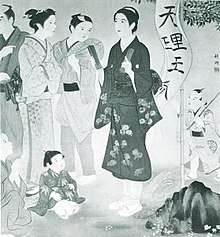God in Tenrikyo
In Tenrikyo, God is a single divine being and creator of the entire universe. The first two characters in the Japanese kanji for Tenri-O-no-Mikoto are 天理, where 天 refers to heaven or divinity, and 理 refers to reason or knowledge, thus "Tenri" (天理) refers to divine or heavenly knowledge, and in a sense adds a divine nature to truth itself whereas "天理" also means "natural law" or its pseudonym, "divine law."[1] The English name most frequently used to refer to Tenri-Ō-no-Mikoto outside of ritual is "God the Parent"; in Japanese, the equivalent common name is Oyagamisama. In Tenrikyo, God has no gender.
| Part of a series on |
| Tenrikyo |
|---|
 |
| People |
| Scripture |
| Supplemental texts |
| Beliefs |
| Practices |
| History |
| Institutions |
| Other |
Tenrikyo followers vary in their understanding of this creator, from the early understanding of spirit (kami, god/deity) through the underlying natural causality (Tsukihi, moon-sun) and eventually to an understanding of a parental relationship between the creator and themselves (oya, parent). This progression of understanding is a key teaching of Tenrikyo, where it is accepted that everything must proceed "step by step" — by small stages of understanding instead of by great leaps of faith.
Names

In historical documents and scriptures related to Tenrikyo, a number of different appellations are ascribed to God.[2]
In the Ofudesaki, God identified as three different entities. In 1869, when the first verses were composed, God initially identified as kami (神), a spirit in the Japanese Shinto tradition. The designation kami was broader than the Abrahamic notion of God, as it could be applied to any object that possessed divine power or inspired awe, such as animals, trees, places, and people. However, the Ofudesaki stressed the uniqueness of the kami by adding various qualifiers such as moto no kami (God of origin), shinjitsu no kami (God of truth), and kono yō o hajimeta kami (God who began this world).[3] From 1874, God began to identify as tsukihi (月日), or moon-sun, and from 1879, God began to identify as oya (をや), or parent, though kami and tsukihi continued to be used until the last part of the scripture.[4]
In Tenrikyo's creation story, outlined in the Ofudesaki and elaborated upon in various notes on her talks known collectively as kōki, there are ten figures credited with the creation of human beings. Some Tenrikyo authorities suggest that two of these figures, Kunitokotachi-no-Mikoto and Omotari-no-Mikoto, represent tsukihi, or more precisely the duality tsuki-sama and hi-sama. The other eight figures are tools subordinate to tsukihi that were drawn in, consulted, and trained in the creation of human beings.[5]
In the Mikagura-uta, the songs of Tenrikyo's liturgy, God is commonly referred to as kami. At the end of most of the songs, God is invoked with the name Tenri-Ō-no-Mikoto, (てんりおうのみこと or 天理王命) or "absolute ruler of divine reason."
The historical sources written during Nakayama Miki's lifetime and in the years following her death suggest a number of other appellations of God. In Nakayama Shinnosuke's Oyasama gyoden, the source on which The Life of Oyasama is primarily based, Miki refers to God as ten no shōgun (Shōgun of Heaven) in the initial revelation. In early attempts to obtain religious sanctions from the Yoshida Administrative Office of Shinto and a Shingon Buddhist temple, the name of God was recorded as Tenrin-Ō-Myōjin (天輪王明神) and Tenrin-Ō-Kōsha (転輪王講社) respectively. An early doctrine of the Tenrikyo church, written to conform to the State Shinto doctrine at the time, records the name as Tenri-Ōkami.
Tenrikyo's current doctrine maintains that Tenri-Ō-no-Mikoto is the divine name to be used in the context of prayer.[6] The doctrine frequently refers to God as God the Parent (親神様 oyagamisama), emphasizing the parental nature of God revealed toward the end of the Ofudesaki.[7] The doctrine claims that the changes in God's names in the Ofudesaki, from kami to tsukihi to oya, were made in accordance with the spiritual growth of the early followers.[8]
Attributes
A number of qualities have been ascribed to God as understood in Tenrikyo, by both Tenrikyo and religious studies scholars.
Healer
Out of a fundamental desire to see people thrive, God, through Nakayama Miki, showed followers several ways by which they could receive God's healing power. At first, Miki administered the grant of safe childbirth, where she would lay her hands and breathe on the hands of pregnant women and would assure them of easy delivery if they relied on God. Later, Miki taught a healing prayer called the Sazuke and a liturgy called the Service, intended as specific rituals followers could perform to heal people physically and spiritually. In addition, Miki gave sacred amulets to those who had visited her residence, which she said would protect her followers from disease and decay. However, Miki asserted that, for God's healing to be effective, the participants must have full faith in God and the desire to purify their hearts (Ofudesaki X:20–24, XII:91–94).[9]
Immanence
In Tenrikyo, God is immanent in the sense that God provides for all matter in the universe, such as human bodies, living organisms and inanimate objects, and sustains all of the physical processes behind them. In the Ofudesaki, the universe is referred to as the "body of God" (Ofudesaki III:40, 135).[10] In Tenrikyo's doctrine, God's providence over the universe explained as the "ten aspects of God's complete providence" (十全の守護 jūzen no shugō; see section on Providences).
Omnipotence
A frequently appearing term in the Ofudesaki is jūyō or jūyōjizai, translated as "omnipotence" or "free and unlimited workings." This omnipotence permeates the physical world and its laws, for example, the God of Tenrikyo is the cause of natural disasters such as rainstorms and earthquakes (Ofudesaki VI:91), and of events in one's personal life, such as dreams and diseases (Ofudesaki VIII:58). However the physical laws of the world can be superseded at times in order to produce miracles, which suggests that God's power is not purely mechanical or rigid.[11][12]
Omniscience
The Ofudesaki imply God's omniscience by asserting that there is nothing that God does not know (Ofudesaki VIII:11, XVI:42) and that God scrutinizes the hearts of all people (VIII:52–3, XVII:29). With this omniscience, God gives appropriate returns to each individual depending on how close his or her mind is in accordance with God's intention.[13]
Personhood
In Tenrikyo, God is a personal god who acts as an idealized parent. Just as parents conceive and raise their children, God took part in the conception of human beings and continues to be involved in their upbringing. God moves, plans, acts, and expresses emotions such as love and regret in order to guide human beings toward greater spiritual maturity and joy.[12][14]
Transcendence
The God of Tenrikyo transcends time and space and rejects systematic classification. Because of this quality, God has the ability to become finite and limited so that God's teachings could be understood by human beings, i.e. through the life and writings of Nakayama Miki.[15]
Revelation
Tenrikyo's doctrine claims that God was revealed through Nakayama Miki on the lunar calendar date of 26 October 1838, in order to clarify the means of humankind's salvation. Because God was hidden before that time, God's teachings could not be fully understood by human beings. [16] Verses in the Ofudesaki acknowledge the revealed nature of God (e.g. I:3, XI:67), and the Osashizu makes a number of references to the time when God became revealed.[17]
Providences
The immanent providence of God in Tenrikyo is distinguished into ten aspects, each endowed with a sacred name, a function in the human body, and a function in the world.[18] These aspects are represented by dancers in the portion of Tenrikyo's liturgy known as the Kagura Service.
| Sacred name | Function in the human body | Function in the world |
|---|---|---|
| Kunitokotachi-no-Mikoto | eyes and fluids | water |
| Omotari-no-Mikoto | warmth | fire |
| Tsukiyomi-no-Mikoto | male organ, bones and support | support |
| Kunisazuchi-no-Mikoto | female organ, skin and joining | joining |
| Otonobe-no-Mikoto | pulling out the child from its mother at birth | pulling forth |
| Kumoyomi-no-Mikoto | eating, drinking and elimination | rise and fall of moisture |
| Kashikone-no-Mikoto | breathing and speaking | wind |
| Taishokuten-no-Mikoto | cutting off the ties of the child from its mother at birth, cutting off the breath of life when passing away for rebirth | cutting |
| Izanagi-no-Mikoto | model of man, the seed | model of man, the seed |
| Izanami-no-Mikoto | model of woman, the seedplot | model of woman, the seedplot |
History
In 1880, in order to evade continuous persecution by the government, Tenrikyo placed itself under the administration of a Shugendo temple named Jifukuji. During this time Tenri-Ō-no-Mikoto was officially called Tenrin-Ō-Nyorai and the kanji of various other deities were changed, but by 1890 Tenrikyo was given approval by the Meiji government and the original names were restored.[19]
References
Citations
- Breen, Jim. "天理". The Yamasa Institute - オンライン日本語学習 - Online Kanji Dictionary. The Yamasa Institute. Retrieved 9 July 2017.
- Ellwood 1982, p. 81.
- Becker 1979, p. 2.
- Becker 1979, pp. 3–4.
- Becker 1979, p. 9.
- Tenrikyo Church Headquarters 1993, p. 29.
- Tenrikyo Church Headquarters 1993, p. 10.
- Tenrikyo Church Headquarters 1993, pp. 8–10.
- Becker 1979, pp. 18–20.
- Iida 1986, pp. 56–58.
- Becker 1979, pp. 12–14.
- Ellwood 1982, p. 82.
- Becker 1979, pp. 15.
- Iida 1986, p. 58–62.
- Iida 1986, p. 54–8.
- "God the Parent, Tenri-O-no-Mikoto," Kaitei Tenrikyo jiten, pp. 141–142.
- Sawai 1986, pp. 23–5.
- Tenrikyo Church Headquarters 1993, pp. 30–1.
- Henry van Straelen. "The Religion of Divine Wisdom: Japan's Most Powerful Religious Movement." Folklore Studies, Vol. 13, (1954), pp. 1-166
Bibliography
- Becker, Carl B. (1979). "Concepts and roles of God in Tenrikyo". Tenri Journal of Religion. 13: 1–28.CS1 maint: ref=harv (link)
- Ellwood, Robert, S. (1982). Tenrikyo, a Pilgrimage Faith: The Structure and Meanings of a Modern Japanese Religion. Tenri, Japan: Tenri University Press.CS1 maint: ref=harv (link)
- Iida, Teruaki (1986). "A study on "God the Parent"". Tenri Journal of Religion. 20.CS1 maint: ref=harv (link)
- Sawai, Yuichi (1986). "The origin of Tenrikyo – with reference to the Osashizu, the Divine Directions –". Tenri Journal of Religion. 20: 23–42.CS1 maint: ref=harv (link)
- Tenrikyo Church Headquarters (1993). The Doctrine of Tenrikyo. Tenrikyo Church Headquarters.CS1 maint: ref=harv (link)
Further reading
- Arakawa, Yoshihiro (2010). "A study on the teaching: "This universe is the body of God"". Tenri Journal of Religion. 38.CS1 maint: ref=harv (link)
- Marras, Pino (1983). "Man world god: Tenrikyo anthropological, cosmic and theological perspectives – reflections from the outside –". Tenri Journal of Religion. 17.CS1 maint: ref=harv (link)
- Nakajima, Hideo (1986). "Some problems on the idea of God the Parent". The Theological Perspectives of Tenrikyo. Tenri University Press. pp. 71–78.CS1 maint: ref=harv (link)
- Sawai, Yoshitsugu (1985). "The providence of God the Parent – toward the understanding of Tenrikyo cosmology". Tenri Journal of Religion. 19.CS1 maint: ref=harv (link)
- Sawai, Yoshitsugu (1999). "The appellations of God the Parent: an analysis of "God," "Tsukihi," and "Parent"". Tenri Journal of Religion. 27.CS1 maint: ref=harv (link)